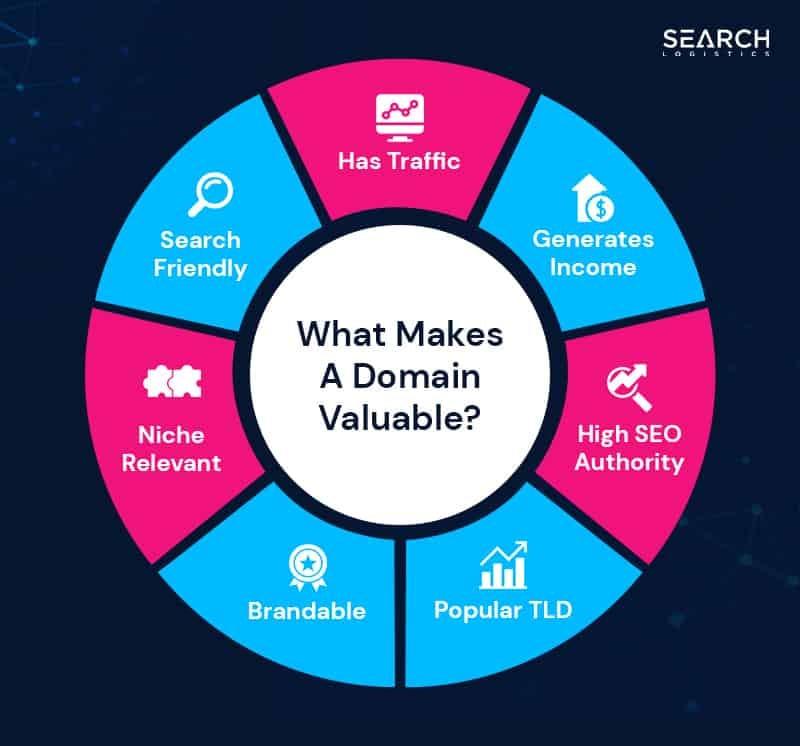Table of Contents
- Exploring the Basics of Domain Flipping and Its Profit Potential
- Identifying Valuable Domains: Key Factors to Consider
- The Art of Valuation: How to Price Domains Effectively
- Marketing Your Domains: Strategies for Successful Sales
- Navigating the Legal Landscape: Ensuring a Smooth Transaction
- Q&A
- Concluding Remarks


Exploring the Basics of Domain Flipping and Its Profit Potential
Domain flipping is the practice of buying domain names at a low price and selling them at a profit. This can be an exciting venture for both beginners and seasoned entrepreneurs. At its core, the idea revolves around identifying valuable domain names that have the potential to attract interest from buyers, whether they’re businesses, bloggers, or e-commerce sites. Key factors to consider when selecting domains include:
- Length: Shorter domains tend to be more memorable and desirable.
- Keywords: Including relevant keywords can enhance search engine rankings.
- Domain extensions: Popular extensions like .com or .net are typically more valuable.
After acquiring a domain, the next step is to consider its marketing strategy. Successful flipping often hinges on attracting potential buyers through various channels. Some effective tactics include:
- Listing on domain marketplaces: Websites like Flippa and Sedo can connect sellers with interested buyers.
- Social media promotion: Utilizing platforms like Twitter or LinkedIn can garner attention.
- Email outreach: Targeted emails to businesses that fit the domain’s niche can yield results.
The profit potential in domain flipping is noteworthy, but a savvy approach is crucial. Many successful flippers keep a detailed record of their transactions and trends in the market. Tracking factors such as:
| Domain Name | Purchase Price | Sale Price | Profit |
|---|---|---|---|
| example1.com | $10 | $300 | $290 |
| example2.net | $20 | $150 | $130 |
| example3.org | $15 | $90 | $75 |
This helps to identify what types of domains are trending and what pricing strategies work best. with the right knowledge and patience, flipping domains can transform into a lucrative online business venture.
Identifying Valuable Domains: Key Factors to Consider
When it comes to discovering domains with potential, several distinct factors can make or break their value. First and foremost, the length of the domain plays a crucial role; shorter domains are generally more memorable and user-friendly. Additionally, consider the keyword relevance; a domain that includes popular or trending keywords can yield significant traffic and appeal to businesses in that niche. To maximize your investment, prioritize domains that resonate well with current industry trends or needs.
Another factor to assess is the age of the domain. Older domains often come with established authority and trust, which is attractive to potential buyers. Additionally, check for existing backlinks; a domain with a rich backlink profile can provide immediate SEO advantages. Keep in mind the importance of checking the domain’s history as well—domains that have been previously penalized or associated with spam can become liabilities rather than assets.
Lastly, don’t overlook the extension of the domain. While .com extensions are the most sought after, other extensions like .co, .net, and even geographic or niche-specific TLDs can hold value depending on their context. Furthermore, regional markets open a doorway to unique opportunities; local extensions can attract businesses and users in specific areas. A well-rounded approach, balancing all these factors, will not only enhance your ability to identify valuable domains but will also set the stage for lucrative flipping opportunities.


The Art of Valuation: How to Price Domains Effectively
Determining the right price for a domain requires a keen understanding of various factors that contribute to its value. One of the primary elements is the domain’s length; shorter domains are generally more desirable as they are easier to remember and type. Additionally, the presence of targeted keywords can significantly enhance a domain’s appeal. Consider these essential aspects when assessing value:
- Brandability: Is the domain catchy and easy to pronounce?
- Extensions: .com domains tend to command higher prices than others.
- Market trends: Are there any shifts in consumer behavior affecting demand?
Another critical factor in domain valuation is comparable sales. Researching recent sales of similar domains can provide valuable insights into what buyers are willing to pay. Utilize domain marketplaces to gauge ongoing listings and auction results. This approach can help you establish a competitive price point that reflects current market conditions. Here’s a simple comparison table to illustrate how similar domains can vary based on attributes:
| Domain Name | Sale Price | Length | Keywords |
|---|---|---|---|
| BestWidgets.com | $5,000 | 10 | Widgets |
| WidgetsPro.com | $3,500 | 10 | Widgets, Pro |
| SupremeWidgets.com | $2,000 | 12 | Widgets |
always consider the potential use of the domain. A domain that holds promise for development into a lucrative business could be priced higher, especially if it fits a specific niche with growing demand. Engage with prospective buyers by highlighting the unique benefits of the domain you are selling. Presenting a compelling case can greatly influence the perceived value and lead to successful negotiations.


Marketing Your Domains: Strategies for Successful Sales
When it comes to selling domains, implementing effective marketing strategies can significantly increase your chances of finding the right buyer. Start by establishing a strong online presence for your domains. Create a dedicated website or landing page showcasing your portfolio, complete with detailed domain descriptions, pricing, and potential use cases. Utilize SEO techniques to improve visibility; incorporate relevant keywords in your content to attract organic traffic from search engines. Additionally, consider leveraging social media platforms and community forums to share your listings and connect with potential buyers.
Building relationships within the domain flipping community and related industries can yield fruitful results. Participate in forums, webinars, and events where domain enthusiasts gather. Networking can lead to valuable opportunities, such as partnerships, joint ventures, or exclusive sales channels. Sharing your expertise and experiences in these spaces not only enhances your credibility but also helps you gain insights into market trends and buyer preferences. Consider joining online platforms specifically designed for domain trading, where you can list your domains alongside those of other sellers.
To evaluate the effectiveness of your marketing strategies, track metrics such as website traffic, conversion rates, and engagement on social media. Use tools like Google Analytics to understand what is working and what needs improvement. You can create a simple table to keep track of these metrics over time:
| Month | Website Visits | Conversion Rate (%) | Social Media Engagement |
|---|---|---|---|
| January | 1,500 | 2.5 | 300 |
| February | 2,000 | 3.0 | 450 |
| March | 2,500 | 3.5 | 600 |
With these strategies in place, your domain marketing efforts can become more targeted and effective, ultimately leading to successful sales.


Navigating the Legal Landscape: Ensuring a Smooth Transaction
When diving into the domain flipping business, it’s crucial to understand the various legal implications that can affect your transactions. First and foremost, you should familiarize yourself with trademark laws and intellectual property rights. It’s essential to ensure that the domains you are purchasing or selling do not infringe on existing trademarks. This not only protects you from potential disputes but also helps you maintain a reputable standing in the marketplace. Key aspects to consider include:
- Conducting a Trademark Search: Utilize resources like the USPTO database to avoid any conflicts.
- Understanding Cybersquatting Regulations: Familiarize yourself with the ACPA (Anticybersquatting Consumer Protection Act) and its implications.
- Domain Name Ownership Verification: Always verify the ownership of a domain before proceeding with a transaction.
Moreover, it’s beneficial to draft a solid sales agreement that outlines the details of the transaction. This document should clearly specify the purchase price, payment methods, and any other conditions that must be met for the transaction to be valid. Having a well-crafted agreement helps mitigate risks by ensuring that both parties understand their rights and responsibilities. Key elements to include in your agreement might be:
| Element | Description |
|---|---|
| Purchase Price | The total amount agreed upon for the domain. |
| Payment Method | Specify if payment is made through PayPal, bank transfer, etc. |
| Transfer Protocol | Outline the steps of transferring domain ownership post-payment. |
Lastly, it is prudent to consider the implications of privacy laws that may affect your transactional processes and how you handle sensitive information. Ensure that you comply with national and international regulations, such as GDPR if you’re operating in Europe. This not only protects your buyers but also your business from potential fines. Stay updated with changes in legislation related to online transactions, as this can significantly influence your strategies in the domain flipping market.
Q&A
Learn Domain Flipping: Q&A
What is domain flipping?
Domain flipping is the practice of purchasing domain names at a low price and selling them at a higher price. Think of it as a digital real estate business. Investors seek out valuable or trending domain names, buy them, and then resell them to interested buyers or businesses for profit.Why should I consider domain flipping?
Domain flipping can be a lucrative side hustle or even a full-time business. With the increasing demand for online presence, businesses are constantly looking for the perfect domain to establish their brand. If you have a knack for spotting valuable domains, this could be a great opportunity for you.How do I start learning about domain flipping?
Start by researching the basics of domain names and the marketplace. There are numerous online resources, articles, and courses available that cover domain research, valuation, and selling techniques. Familiarize yourself with platforms like GoDaddy, Namecheap, and Flippa, which are popular marketplaces for buying and selling domains.What makes a domain name valuable?
Several factors can determine a domain’s value, including:- Length: Shorter domain names are generally more desirable.
- Keywords: Domains that contain popular search keywords can be more valuable for SEO purposes.
- Extension: Common extensions like .com tend to have higher value than less popular ones.
- Brandability: A catchy and memorable domain often attracts premium prices.
- Traffic: Existing traffic can significantly increase a domain’s value.
Where can I buy domains for flipping?
You can buy domains from various registrars, including:- GoDaddy: One of the largest domain registrars with a wide selection.
- Namecheap: Known for competitive pricing and user-friendly services.
- Bluehost: Offers domain registration along with hosting plans.
- Flippa: A marketplace where users can buy and sell established domains.
How can I sell my domains?
Selling your domains can be done through:- Domain Marketplaces: Platforms like Flippa, Sedo, and Afternic allow you to list your domain for sale.
- Direct Sales: Reach out to potential buyers through email or social media, especially if you identify businesses that may find your domain valuable.
- Auction Sites: List your domain on auction sites, which can generate bidding and potentially higher sale prices.
What are the risks involved in domain flipping?
As with any investment, domain flipping comes with risks. Some of these include:- Valuation Errors: Misjudging a domain’s worth can lead to losses.
- Market Changes: Trends can shift, leaving previously valuable domains less appealing.
- Holding Costs: Domain registration fees can accumulate if you hold onto domains longer than necessary.
How much should I expect to invest initially?
Your initial investment varies based on your strategy. Domains can be purchased as cheaply as $10 to $20, while premium domains can cost hundreds or thousands of dollars. It’s advisable to start small, gain experience, and gradually scale your investment.Can I make a full-time income from domain flipping?
While it’s possible to make a substantial income flipping domains, success depends on your knowledge, strategy, and effort. Many full-time domain flippers invest significant time into research, networking, and marketing their domains. Commitment to continuous learning and adaptation to market trends is essential.What tips do you have for someone just starting?
- Do Your Research: In-depth research will inform your purchasing decisions.
- Think Long-Term: Some domains may take time to sell; don’t rush into selling.
- Network: Join online communities and forums related to domain investing to learn from others.
- Start Small: Focus on a few quality domains instead of investing in many less desirable options.
- Stay Updated: The domain market is dynamic; keep abreast of trends and changes.

